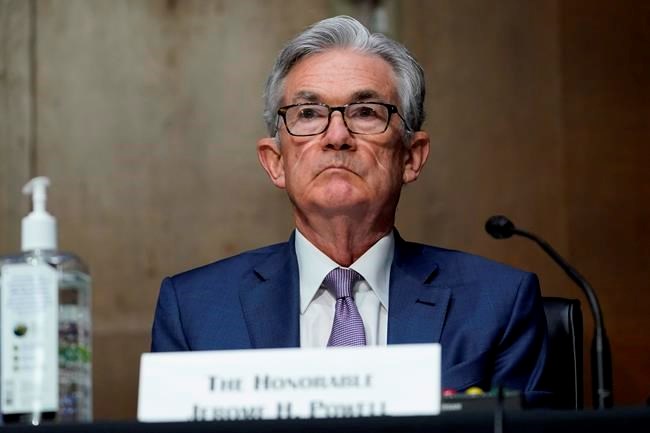WASHINGTON — The Federal Reserve foresees the economy accelerating quickly this year yet still expects to keep its benchmark interest rate pinned near zero through 2023, despite concerns in financial markets about potentially higher inflation.
With its brightening outlook, the Fed on Wednesday significantly upgraded its forecasts for growth and inflation. It now expects the economy to expand 6.5% this year, up sharply from its previous projection in December of 4.2%. And the Fed raised its forecast for inflation by the end of this year from 1.8% to 2.4% after years of chronically low price increases.
The Fed also said it would continue its monthly purchases of $120 billion in bonds, which are intended to keep longer-term borrowing costs low.
On Wall Street, investors registered their approval of the Fed's low-rate message, sending stock indexes higher. And the closely watched yield on the 10-year Treasury note, which has surged in recent weeks on inflation concerns, declined slightly.
Still, the Fed's upgraded forecasts raised questions about what would cause it eventually to raise its key short-term rate, which affects many consumer and business loans. As the economy strengthens, the policymakers think the unemployment rate will drop faster than they thought in December: They foresee unemployment falling from its current 6.2% to 4.5% by year's end and to 3.9%, near a healthy level, at the end of 2022.
That suggests that the central bank will be close to meeting its goals by 2023, when it expects inflation to exceed its 2% target level and for unemployment to be at 3.5%, which is where it was before the pandemic struck. Yet it still doesn't project a rate hike then.
At a news conference after the Fed's latest policy meeting, Chair Jerome Powell stressed that the central bank wants to see substantial improvement in the job market and economy and won't reverse its low-rate policies based solely on forecasts. Last year, the Fed altered its policy framework to make clear that it would eventually raise rates only after annual inflation had exceeded its 2% target “for some time” — and not just when higher inflation appeared likely.
On Wednesday, Powell appeared intent on emphasizing that shift.
“We’re going to wait to see actual data," he said. "And I think it will take people time to adjust to that new practice. And the only way we can really build the credibility of that is by doing it.”
Brian Bethune, an economics professor at Tufts University, said: “The message here is that the Fed is not concerned about inflation right now. The trend around the world is toward lower inflation. Since that is the case, the Fed is saying, why worry about it? This low inflation trend is the Fed’s friend.”
There were signs, though, that at least some Fed officials are edging closer to reining in the central bank's ultra-low-rate policies. The central bank indicated that four of the 18 policymakers now expect a rate hike in 2022, up from just one in December. And seven predict a hike in 2023, up from five in December. The Fed doesn't name which officials make which projections.
At the same time, Powell downplayed the notion that Fed officials can accurately project their policies well past this year.
“The state of the economy in two or three years is highly uncertain," he said, “and I wouldn’t want to focus too much on the exact timing of a potential rate increase that far into the future.”
The Fed chair also credited the government's emergency spending, including substantial relief packages approved by both Presidents Donald Trump and Joe Biden, with preventing an even worse downturn from shuttered small businesses and workers losing jobs permanently.
Still, the Fed doesn't expect the unemployment rate to return to its pre-pandemic level of 3.5% until late 2023.
“The faster the better,” Powell said, “but realistically, given the numbers, it's going to take some time.”
At the moment, Powell faces a delicate balancing act: The economy is clearly improving. But if the chairman is perceived to be too optimistic, investors might assume the Fed will reverse its low-rate policies prematurely. That could send bond yields rising and weaken the economy as borrowing becomes costlier for companies and households.
Yet if Powell sounds worried that the job market is recovering only slowly, it might spark concerns that the Fed won't be watchful enough about inflation pressures. That perception, too, could send bond yields rising as investors anticipate rising inflation.
On Wednesday, the chairman downplayed the prospect that inflation could eventually surge out of control.
“There was a time when inflation went up, it would stay up," he said at the news conference. “And that time is not now. That hasn’t been the case for some decades.”
This week's Fed policy meeting came as the economy’s outlook has improved significantly since it last met in late January. Job gains accelerated in February, sales at retail stores jumped after $600 relief checks were distributed at the start of the year and Biden signed his economic relief package into law. Average daily COVID infections have also dropped precipitously. And vaccinations have accelerated, raising hopes that Americans will increasingly travel, shop, eat out and spend freely after a year of virus-induced restraint.
As a consequence, economists have been upgrading their outlooks, with many predicting that the economy will expand as much as 7% for all of 2021. That would be the fastest annual growth since 1984. The brighter outlook has sent the yield on the 10-year Treasury note climbing as investors have dumped bonds, which are typically safe-haven investments during downturns.
Still, the job market has a long way to go to a full recovery. With unemployment at 6.2%, the economy still has 9.5 million fewer jobs than it did before the pandemic struck a year ago.
Christopher Rugaber And Martin Crutsinger, The Associated Press



